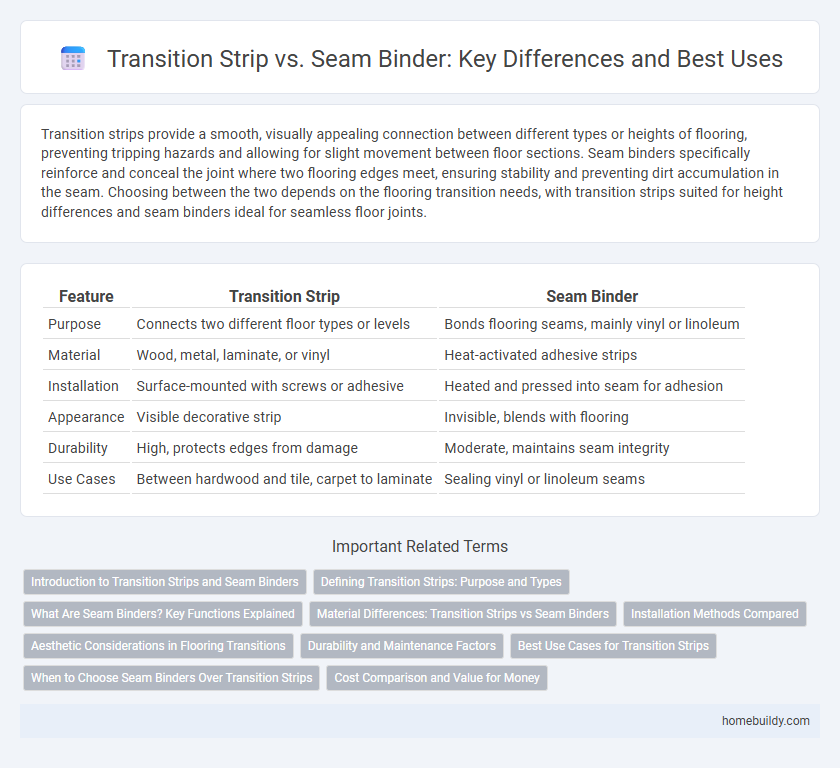Transition strips provide a smooth, visually appealing connection between different types or heights of flooring, preventing tripping hazards and allowing for slight movement between floor sections. Seam binders specifically reinforce and conceal the joint where two flooring edges meet, ensuring stability and preventing dirt accumulation in the seam. Choosing between the two depends on the flooring transition needs, with transition strips suited for height differences and seam binders ideal for seamless floor joints.
Table of Comparison
| Feature | Transition Strip | Seam Binder |
|---|---|---|
| Purpose | Connects two different floor types or levels | Bonds flooring seams, mainly vinyl or linoleum |
| Material | Wood, metal, laminate, or vinyl | Heat-activated adhesive strips |
| Installation | Surface-mounted with screws or adhesive | Heated and pressed into seam for adhesion |
| Appearance | Visible decorative strip | Invisible, blends with flooring |
| Durability | High, protects edges from damage | Moderate, maintains seam integrity |
| Use Cases | Between hardwood and tile, carpet to laminate | Sealing vinyl or linoleum seams |
Introduction to Transition Strips and Seam Binders
Transition strips are flooring accessories designed to bridge gaps between different types of flooring materials, providing a smooth and safe surface. Seam binders specifically secure and conceal the joints between two flooring sections, preventing separation and improving durability. Both components enhance flooring aesthetics but serve distinct functions for installation and maintenance.
Defining Transition Strips: Purpose and Types
Transition strips bridge gaps between different flooring materials, ensuring a smooth and safe surface while accommodating variations in height. Common types include T-molding, reducer strips, and threshold strips, each designed for specific transitions like connecting hardwood to tile or laminate to carpet. These strips not only enhance aesthetic continuity but also prevent tripping hazards and floor damage over time.
What Are Seam Binders? Key Functions Explained
Seam binders are specialized strips designed to reinforce and protect the edges of flooring seams, preventing separation and wear over time. Unlike transition strips, which primarily cover the junction between different flooring types or levels, seam binders focus on securing the joint areas within the same flooring material for enhanced durability. Their key functions include providing stability, minimizing moisture ingress, and maintaining a smooth, safe surface in high-traffic areas.
Material Differences: Transition Strips vs Seam Binders
Transition strips are typically made from durable materials such as wood, aluminum, or vinyl designed to create a smooth height transition between different flooring types. Seam binders are usually crafted from metal or plastic, focusing on securing and protecting the seam between flooring panels rather than bridging height differences. The material choice in transition strips emphasizes flexibility and aesthetic integration, while seam binders prioritize strength and seam reinforcement.
Installation Methods Compared
Transition strips typically use adhesive backing or screws for installation, allowing for easy adjustment and removal. Seam binders require precise heat application to melt and fuse edges of two surfaces together, ensuring a seamless and permanent bond. Installation of transition strips is generally quicker and less specialized than the time-consuming, skill-intensive process needed for seam binders.
Aesthetic Considerations in Flooring Transitions
Transition strips enhance flooring transitions by providing a smooth visual and functional change between different floor types or levels, ensuring a polished and cohesive appearance. Seam binders focus primarily on securing and protecting floor seams, often prioritizing durability over aesthetic appeal. Choosing a transition strip over a seam binder is ideal for maintaining a seamless and attractive flooring design that complements interior decor.
Durability and Maintenance Factors
Transition strips offer superior durability compared to seam binders due to their robust materials like aluminum and hardwood, which resist wear and tear in high-traffic areas. Maintenance for transition strips is minimal, often requiring only regular cleaning and occasional tightening, while seam binders may degrade faster and need frequent replacement or repair. Choosing transition strips helps ensure long-term stability and reduces upkeep costs in flooring transitions.
Best Use Cases for Transition Strips
Transition strips are best used to bridge gaps between different flooring types, such as hardwood to tile or laminate to carpet, ensuring a smooth and safe surface transition. They provide flexibility for height differences and movement, making them ideal for doorways and room thresholds where expansion gaps need to be covered. Unlike seam binders, which primarily secure carpet seams, transition strips offer both functional and aesthetic benefits in varied flooring junctions.
When to Choose Seam Binders Over Transition Strips
Seam binders are ideal for securely joining hardwood flooring seams without raising surface levels, making them preferable when maintaining a smooth, continuous floor plane is crucial. Transition strips work best for connecting different flooring types or varying heights, but seam binders provide a stronger, more seamless bond for hardwood expansions. Choose seam binders when precise alignment and long-term durability of hardwood seams are top priorities.
Cost Comparison and Value for Money
Transition strips typically cost less than seam binders, offering an affordable solution for covering gaps between different flooring materials. Seam binders provide a more durable and visually seamless finish, justifying their higher price with longer-lasting performance and better aesthetic appeal. For budget-conscious projects, transition strips deliver excellent value, while seam binders serve as a premium option where durability and appearance are prioritized.
Transition strip vs Seam binder Infographic

 homebuildy.com
homebuildy.com